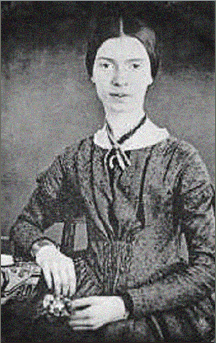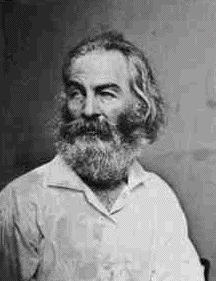 |
LITR 4232 American
Renaissance 2012 final exam—Answers to Question B5 "compare and contrast poems by Whitman and Dickinson" final exam assignment |
 |
Andy Feith
Emily Dickinson and the Good Grey Poet
Emily Dickinson’s style of poetry is tightly structured into four-line
stanzas, whereas Whitman’s free verse has an overflowing kind of enthusiasm.
This is the most obvious way to distinguish the authors of the two sample poems;
“A Noiseless Patient Spider” is Whitman’s, and the untitled poem is Dickinson’s.
I contrast Whitman’s enthusiastic free verse to Dickinson’s control and
structure, but this ten-line snippet of a poem does follow certain rules of
symmetry. Both stanzas are comparable in terms of the lengths of their various
lines; i.e., the first line of each stanza is short and introduces the main
character of that stanza (first the spider, then “O my soul”); the following
four lines are a bit longer. Another way of describing this contrast between the
two poets’ styles is to note that Dickinson writes in the tradition of lyric
poetry, while Whitman pioneered free verse, making his own rules as he went
along. “The Noiseless Patient Spider” and “When I Heard the Learn’d Astronomer”
are relatively tightly structured for Whitman; longer poems of his, like “I Sing
the Body Electric,” consist of extremely long catalogs or lists, just one item
after another. Whitman’s self-consciously stubborn insistence is that all of
these little things are worthy of notice, even celebration.
“A Noiseless Patient Spider” addresses the theme the Whitman style sheet
calls “shifting relations between self and other, soul and nature.” The spider
is considered first and keenly observed, with an appreciation for the delicate
labor of making the strands of a web. Whitman then turns to address his own
soul. Where the spider is “on a promontory… isolated” in the midst of “the
vacant vast surrounding,” Whitman’s soul is “surrounded, detached, in
measureless oceans of space.” Both creatures are projecting themselves outward
in some way, trying to make contact with something solid. There is a typical
grandiosity about Whitman’s description of himself here. Dickinson too likes to
address lofty or profound topics, but she is much less likely than Whitman to
focus so much attention on herself in her poems.
This is true of her untitled poem that begins with “There’s been a death
in the opposite house”. She has the speaker of the poem refer to himself in the
poem’s third stanza (“They wonder if It died on that,—/I used to when a boy”),
but the poem as a whole is a description of an external event, the sights and
sounds of a “country town” when there has been a death. One could imagine the
speaker of the poem composing these lines from a window looking out; in fact
this rhetorical position is typical of Dickinson, and death is one of her
favorite topics. What is unusual about this poem is its everyday-ness. Dickinson
simply writes what she sees in an unadorned fashion. In a poem like “Dare you
see a Soul at the White Heat”, by
contrast, or even “I love to see it lap the miles”, she enters the realm of the
metaphysical and describes visions appropriate to biblical prophets or dreams.
The “Forge” and the “Blacksmith” who superheats and shapes the molten “Soul” are
an entirely different subject matter than the “minister” and “milliner” of
Dickinson’s “country town.” There is an exaltation and intensity there that is
absent in “There’s been a death in the opposite house.”
|
|
|

